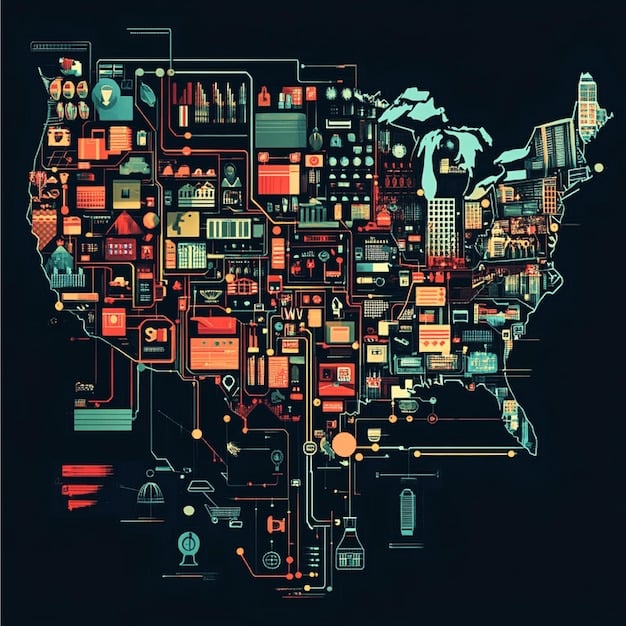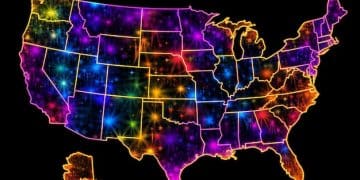Unlocking US Streaming: Guide to Regional Content Restrictions 2025

Navigating the evolving landscape of Unlocking US Streaming: A Comprehensive Guide to Regional Content Restrictions in 2025 is crucial for viewers aiming to access a full spectrum of digital entertainment, as geo-blocking and licensing agreements continue to shape content availability across different regions.
In the expansive and ever-evolving world of digital entertainment, the concept of Unlocking US Streaming: A Comprehensive Guide to Regional Content Restrictions in 2025 has become a central point of discussion for many. As streaming platforms vie for global dominance, the promises of endless content often clash with the realities of geo-restrictions.
Understanding Geo-Restrictions in US Streaming
Geo-restrictions, a ubiquitous aspect of the global streaming landscape, are digital barriers that limit access to content based on a user’s geographical location. For viewers attempting to access US streaming services, these restrictions manifest as frustrating messages like “content not available in your region,” even when residing within US borders. The foundation of these limitations lies primarily in licensing agreements.
Content creators, studios, and distributors negotiate rights for their intellectual property on a region-by-region basis. This fractured approach maximizes revenue by selling exclusive rights to different platforms in various territories. For example, a movie might be available on one service in the US but licensed to a completely different one in Canada or even a different state within the US.
The Legal and Commercial Basis of Geo-Blocking
From a legal standpoint, content distribution is governed by copyright laws that vary internationally. These laws empower rights holders to control where, when, and how their content is disseminated. Commercial considerations often drive these decisions, as platforms bid for exclusivity in specific markets to attract subscribers.
This system, while benefiting rights holders and platforms, inherently fragment the viewing experience for consumers. It means that the “full” library of a global streaming service in the US might differ significantly from its offerings elsewhere, or even within different US states due to local sports blackouts or specific regional licensing deals.
- Copyright Laws: International and national copyright regulations grant exclusive distribution rights.
- Licensing Agreements: Contracts between content creators and platforms define geographical availability.
- Revenue Maximization: Selling exclusive rights by region often yields higher profits for content owners.
- Market Competition: Platforms use exclusive content to gain a competitive edge in specific territories.
The intricate web of these legal and commercial factors ensures that geo-restrictions remain a complex, yet defining, feature of the US streaming ecosystem in 2025.
Key Players and Their Regional Strategies in 2025
The US streaming market in 2025 is dominated by several major players, each employing distinct strategies to manage regional content access. Understanding these approaches is crucial for grasping why certain shows or movies are visible in one US state but not another, or why a service’s overall library might appear inconsistent.
Netflix, for instance, maintains massive global libraries, but its US catalog is distinct due to a blend of original content and regional licensing. Their strategy emphasizes producing universally accessible original series and films, yet external acquisitions are still bound by geographical rights, sometimes leading to content disparities even within the US for specific titles.
Service-Specific Geo-Restriction Approaches
Hulu, often lauded for its robust next-day TV content, primarily focuses on the US market. Its licensing deals are tailored for a US audience, with content availability influenced by network agreements and local broadcast rights. This can create scenarios where local sports broadcasts or specific regional news are geo-blocked in certain areas, even for paid subscribers.
Disney+ and HBO Max, with their expansive content libraries, leverage their intellectual property for global reach. While their core offerings are largely consistent across the US, subtle differences can arise from legacy licensing deals that predate their streaming service launches. For example, some older films or shows might still be tied up in exclusive US regional contracts with other providers.
Live sports streaming services like ESPN+ or regional sports networks (RSNs) are perhaps the most notorious for geo-restrictions. Blackout rules, established to protect local broadcast revenues and stadium attendance, routinely block games from being streamed in specific geographic areas, even if the viewer lives within the team’s market. This presents a unique challenge for sports enthusiasts trying to follow their favorite teams.

The strategies employed by these major streaming players reflect a dynamic balance between maximizing subscriber growth, adhering to complex legal agreements, and navigating an increasingly competitive market. For consumers, this translates into a need for awareness regarding how each service approaches regional content distribution.
Technical Mechanisms Behind Geo-Blocking
The technology underpinning geo-restrictions is sophisticated, primarily relying on internet protocol (IP) address identification. Every device connected to the internet is assigned an IP address, which contains information about its geographical location. Streaming services utilize this data to determine a user’s country, state, or even city, and then apply content restrictions accordingly.
When a user attempts to access geo-restricted content, the streaming platform’s server checks their IP address. If the IP address falls outside the licensed region, access is denied. This fundamental mechanism is combined with more advanced techniques to ensure accuracy and prevent circumvention.
IP Address Tracking and Beyond
Beyond simple IP tracking, streaming providers employ various methods to bolster their geo-blocking capabilities. These can include DNS (Domain Name System) filtering, which blocks access at the domain level if the request originates from an unauthorized region. Another technique involves analyzing GPS data on mobile devices, providing even more precise location information.
Many services also use deep packet inspection (DPI) to analyze data traffic and identify the use of Virtual Private Networks (VPNs) or proxy servers, which are common tools for bypassing geo-restrictions. When detected, these tools are often blocked, preventing access to the content.
- IP Address Detection: Identifying user location through their internet protocol address.
- DNS Filtering: Blocking access by resolving domain names to restricted servers.
- GPS Data (Mobile): Utilizing precise location services on smartphones and tablets.
- Deep Packet Inspection (DPI): Analyzing data packets to detect VPN/proxy usage.
The constant evolution of these technical measures highlights an ongoing digital arms race between streaming services aiming to enforce content rights and users seeking unrestricted access to media. This technological cat-and-mouse game defines a significant aspect of the Unlocking US Streaming: A Comprehensive Guide to Regional Content Restrictions in 2025 landscape.
Impact on US Viewers and Content Consumption
Regional content restrictions significantly shape the streaming experience for US viewers, often leading to frustration and a fragmented perception of content availability. The ideal of a vast, universally accessible library is frequently undermined by the reality of geo-blocking, which dictates what can and cannot be watched in specific locations.
For many, this means being unable to watch a favorite sports team due to local blackouts, or discovering that a highly anticipated show is only available on a different service in a neighboring state. This inconsistency not only diminishes the value proposition of streaming subscriptions but also encourages the search for workarounds.
The Frustration of Fragmentation
The impact extends beyond personal inconvenience; it influences overall content consumption patterns. Viewers might resort to delaying their viewing until content becomes available more broadly, or they might engage in “platform hopping” – subscribing to multiple services to chase specific titles, thus increasing their monthly entertainment expenditure. It also contributes to the perception that the US streaming market is overly complex.
Moreover, content creators and platforms often miss out on potential viewership when their content is locked away from eager audiences within the same country. The balance between protecting regional licensing deals and maximizing audience engagement remains a delicate act. As the US market matures, consumer expectations for seamless access continue to rise, putting pressure on services to rethink their geo-blocking strategies.
Ultimately, regional restrictions create an uneven playing field, where a viewer’s location within the US can dictate their access to popular shows, movies, and live events. This fragmentation directly impacts satisfaction and loyalty within the highly competitive streaming sector.
Strategies for Bypassing US Regional Restrictions
For US viewers determined to circumvent regional content restrictions, several strategies exist, each with varying degrees of effectiveness and legality. While streaming services continuously update their blocking mechanisms, users often seek methods to unlock content not officially available in their specific geographic area.
The most common tool for bypassing geo-restrictions is a Virtual Private Network (VPN). By routing internet traffic through a server in a different location, a VPN masks the user’s actual IP address and makes it appear as if they are accessing the internet from the VPN server’s location. For US-based content, this means selecting a server within a region where the desired content is available.
VPNs, Smart DNS, and Proxy Servers
However, not all VPNs are created equal. Free VPNs often suffer from slow speeds, data limitations, and may not have the robust infrastructure needed to consistently bypass advanced geo-blocking technology. Premium VPNs, on the other hand, offer dedicated streaming servers, faster speeds, and stronger encryption, making them more effective at “Unlocking US Streaming: A Comprehensive Guide to Regional Content Restrictions in 2025.”
Smart DNS services offer an alternative. Unlike VPNs, they don’t encrypt internet traffic, focusing solely on rerouting DNS queries to bypass geo-restrictions. While faster than some VPNs due to lack of encryption overhead, they do not offer the same level of privacy or security. Proxy servers also function similarly to VPNs by masking IP addresses, but they typically provide less security and are more easily detected by streaming services.
- Premium VPNs: Offer encrypted connections and a wide range of server locations to spoof geographical identity.
- Smart DNS: Reroutes DNS requests to bypass geo-blocks without encrypting data, often resulting in faster speeds.
- Proxy Servers: Act as intermediaries, masking IP addresses, but usually offer limited security features.
- Mobile VPNs: Specialized VPNs for mobile devices that can bypass geo-restrictions on the go.
It’s important to note that bypassing geo-restrictions often goes against the terms of service of many streaming platforms. Services actively work to detect and block these tools, leading to an ongoing struggle between content access and content enforcement. Users should be aware of these terms and potential consequences, such as temporary account suspensions, though such instances remain rare.

The Future of Regional Restrictions in US Streaming
As we look further into 2025 and beyond, the landscape of regional content restrictions in US streaming is poised for continued evolution. Several factors are at play, influencing how content is licensed, distributed, and ultimately accessed by viewers across different states and territories.
One significant trend is the increasing vertical integration of media companies. Corporations like Disney, Warner Bros. Discovery, and Comcast are consolidating their content libraries onto their own streaming platforms. This brings a greater degree of control over distribution rights, potentially simplifying some regional licensing complexities over time, especially for their original productions.
Anticipated Changes and Evolving Landscape
However, the demand for local sports coverage and broadcast news will likely keep regional blackouts relevant, particularly for live streaming. As more viewers cut the cord, the financial incentives for protecting local broadcast markets remain strong, making universal access to live regional events a distant prospect.
Technological advancements in geo-location detection will also continue to challenge bypass methods. Streaming services will invest in more sophisticated algorithms to identify and block VPN and Smart DNS usage, forcing these services to perpetually innovate. This cat-and-mouse game is unlikely to cease anytime soon.
- Increased Consolidation: Media giants acquiring more control over their content distribution.
- Persistent Sports Blackouts: Live regional sports content will likely remain geo-restricted.
- Advanced Detection Methods: Streaming services will continue to enhance VPN/proxy detection.
- Consumer Pressure: Growing demand for seamless access may force platforms to reconsider licensing.
Ultimately, the future of geo-restrictions in US streaming will be shaped by a continuous negotiation between legal frameworks, commercial interests, technological capabilities, and evolving consumer expectations for transparent and equitable access to all content, regardless of their specific location within the United States.
| Key Aspect | Brief Description |
|---|---|
| 📍 Geo-Restrictions | Content access limited by user’s geographic location due to licensing. |
| ⚖️ Legal Basis | Driven by copyright laws and exclusive regional licensing agreements for revenue. |
| 🛡️ Bypassing Methods | VPNs and Smart DNS are popular, but subject to detection and blocking by services. |
| 🔮 Future Outlook | Continued technological advancements and evolving licensing models are expected. |
Frequently Asked Questions About US Streaming Restrictions
Content varies due to complex licensing agreements negotiated on a regional or state-by-state basis. These deals secure exclusive rights for specific platforms in certain areas, ensuring maximum revenue for content creators and distributors. Local sports blackouts are a prime example of this.
An IP address is a unique numerical label assigned to every device connected to the internet, indicating its geographical location. Streaming services use this IP address to identify your location and determine whether you are within the licensed region for specific content, enabling geo-blocking.
Using a VPN is generally legal in the US, but bypassing geo-restrictions often violates a streaming service’s terms of service. While it’s rare for individuals to face legal action, services may block your VPN or suspend your account if detected, impacting your ability to access content.
It’s unlikely that regional restrictions will disappear entirely. While media consolidation might reduce some complexities, licensing deals for older content, especially live sports and local news, will continue to drive geo-blocking to protect established revenue streams and local market exclusivity.
Beyond VPNs, Smart DNS services are another option. They reroute your DNS requests, making it appear you’re in a different location, but without encrypting your traffic. Proxy servers can also mask your IP, though they often provide less security and are more easily detected by sophisticated streaming platforms.
Conclusion
The journey of Unlocking US Streaming: A Comprehensive Guide to Regional Content Restrictions in 2025 reveals a landscape continually shaped by a delicate interplay of legal frameworks, business strategies, and technological innovations. While geo-restrictions can be a source of frustration for many viewers, they are deeply entrenched in the economics of content distribution. As streaming platforms evolve and consumer demands shift, the mechanisms for content access will undoubtedly become even more sophisticated. Understanding these dynamics is key for anyone navigating the diverse and sometimes challenging world of online entertainment in the US.





